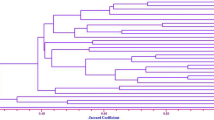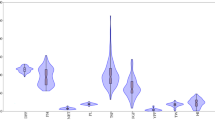Abstract
Rice blast caused by the fungus Magnaporthe grisea is the most devastating rice disease and is severe in upland/dry land culture conditions. Fifty upland rice genotypes, including one resistant check, Pongsu Seribu-1 (PS-1), and one susceptible check, MR219, were evaluated to find out new sources of resistance and assess their diversity based on the reactions against M. grisea. The blast lesion type (BLT) and the percentage of diseased leaf area (% DLA) were assessed following the standard evaluation system introduced by the International Rice Research Institute 7 days after inoculation. Diversity of the 50 rice genotypes was also analysed based on BLT and % DLA. Resistant reactions were observed with the genotypes Biaw Bood Pae, Blau Noc, Chirikata 2, IPPA, IR 5533-50-1-10, IR 5533-55-1-11, Ja Hau, Ja No Naq, BR26, BRRI Dhan42, and BRRI Dhan43. The 50 genotypes were grouped into five clusters. Although the cluster analysis grouped the genotypes with greater similarity of their reactions, but it did not seem necessarily that all the clusters were formed according to the same reactions or origin. The higher range of inter-cluster distance indicated wider diversity among the populations. This information is useful for selecting suitable genotypes for hybridisation programmes for the development of blast-resistant varieties. The identified resistant genotypes could be used as new sources of resistance to develop durable blast-resistant high-yielding upland rice varieties for challenging environments under water scarcity conditions, in addition to studying the mechanism of resistance in future breeding programmes.



Similar content being viewed by others
References
Ashkani S (2011) Molecular dissection and QTL mapping of rice blast disease resistance using simple sequence repeat markers. PhD thesis. Universiti Putra Malaysia p 82
Ashkani S, Yusop MR, Shabanimofrad M, Harun AR, Sahebi M, Latif MA (2014) Genetic analysis of resistance to rice blast: a study on the inheritance of resistance to the blast disease pathogen in an F3 population of rice. J Phytopathol. doi:10.1111/jph.12323
Chen H (2001) Population structure of Pyricularia grisea from central and southern China and comparative mapping of QTL for blast-and bacterial blight-resistance in rice and barley. PhD thesis, Huazhong Agriculture University, Wuhan, China
Correa-Victoria FJ, Zeigler RS (1993) Pathogenic variability in Pyricularia grisea at a rice blast “hot spot” breeding site in Eastern Colombia. Plant Dis 7:1029–1035
Getachew G, Alemu T, Tesfaye K (2013) Evaluation of disease incidence and severity and yield loss of finger millet varieties and mycelial growth inhibition of Pyricularia grisea isolates using biological antagonists and fungicides in vitro condition. J Applied Biosci 73:5883–5901
Ghazanfar MU, Habib A, Sahi ST (2009) Screening of rice germplasm against Pyricularia oryzae the cause of rice blast disease. Pakistan J Phytopathol 21(1):41–44
Haq IM, Fadnan M, Jamil FF, Rehman A (2002) Screening of rice germplasm against Pyricularia oryzae and evaluation of various fungitoxicants for control of disease. Pakistan J Phytopathol 14(1):32–35
Idowu OO, Salami AO, Ajayi SA, Akinwale RO, Sere Y (2013) Varietal resistance of rice to blast fungus Magnaporthe oryzae at two sites in southwestern Nigeria. Afr J Biotechnol 12(33):5174–5182. doi:10.5897/AJB2012.2959
International Rice Research Institute (1996) Standard evaluation system for rice. 4th edn. Manila, the Philippines p 52
International Rice Research Institute (1975) Major research in upland rice. Diseases of upland rice and their control through varietal resistance, Los Banos, p 126
Jagadeb PN, Samal KM (1991) Multivariate analysis in niger (Guizotica abyssinicacass). Indian J Genet 30(1):212–221
Jia Y, Adams SAM, Bryan GT, Hershay HP, Valent B (2000) Direct interaction of resistance genes products confer rice blast resistance. Embryol J 19:4004–4014
Khan JA, Jamil FF, Cheema AA, Gill MA (2001) Screening of rice germplasm against blast disease caused by Pyricularia oryza. In: Proc. Natl Conference of Plant Pathol, held at NARC, Islamabad, pp 86–89
Koutroubas SD, Katsantonis D, Ntanos DA, Lupotto E (2009) Blast disease influence on agronomic and quality traits of rice varieties under Mediterranean conditions. Turkish J Agr 33:487–494
Meena BS (2005) Morphological and molecular variability of rice blast pathogen Pyricularia grisea (Cooke) Sacc. MS thesis. Dharwad University of Agricultural Sciences, Dharwad
Miah G, Rafii MY, Ismail MR, Puteh AB, Rahim MA, Latif MA (2015) Recurrent parent genome recovery analysis in a marker-assisted backcrossing program of rice (Oryza sativa L.). C R Biologies 338:83–94
Mousanejad S, Alizadeh A, Safaie N (2010) Assessment of yield loss due to rice blast disease in Iran. J Agr Sci Technol 12:357–364
Ou SH (1985) Rice diseases, 2nd edn. Commonwealth Mycological Institute, Kew
Padmavathi G, Ram T, Satyanarayana K, Mishra B (2005) Identification of blast (Magnaporthe grisea) resistance genes in rice. Curr Sci 88:628–630
Park NK (1993) Classification of rice cultivars by the rice blast reaction and its utilization for breeding. PhD thesis, Chungnam National University, Taejon, Korea
Pasha A, Babaeian-Jelodar N, Bagheri N, Nematzadeh G, Khosravi V (2013) A field evaluation of resistance to Pyricularia oryzae in rice genotypes. Int J Agri and Crop Sci 5(4):390–394
SES (Standard Evaluation System for Rice) (2014) International Rice Research Institute 5th edn. Manila, the Philippines p 19
Zeigler RS, Leong SA, Teng PS (1994) Rice blast disease. International rice research institute. CAB International, Wallingford, p 35
Acknowledgments
Mst. Tuhina Khatun would like to express her gratitude to the Organization for Women in Science for the Developing World (OWSD) for awarding PhD fellowships. The Long-term Research Grant Scheme (LRGS), Food Security Project, Ministry of Education, Malaysia (LRGS 5525001) supported this research. Mst. Tuhina Khatun, also extends her special thanks to the authority of the Bangladesh Rice Research Institute for providing deputation during her study period.
Conflict of interests
The authors declare that there is no conflict of interest regarding the publication of this article.
Author information
Authors and Affiliations
Corresponding author
Rights and permissions
About this article
Cite this article
Tuhina-Khatun, M., Hanafi, M.M., Wong, M.Y. et al. Reactions and diversity analysis of upland rice genotypes against blast disease of rice (Oryza sativa L.). Australasian Plant Pathol. 44, 405–412 (2015). https://doi.org/10.1007/s13313-015-0359-2
Received:
Accepted:
Published:
Issue Date:
DOI: https://doi.org/10.1007/s13313-015-0359-2




